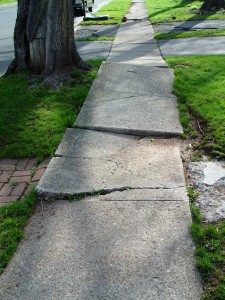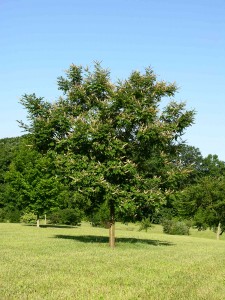Good Street Trees
October 13th, 2011
By the time you add up all the ice storms, tornados, hurricane remnants and plain-vanilla windstorms that blow through in a typical central-Pa. weather year, that’s a lot of trees on the ground.
Sometimes people are “gun-shy” about replacing trees that have failed. Others go so far as to cut down perfectly healthy trees “just in case.”
Trees offer us so many benefits that it’s counter-productive to let a fall-down fear rule a replanting decision — especially when most threats can be prevented. (See https://georgeweigel.net/favorite-past-garden-columns/gun-shy-about-trees for more on this.)
Choosing wisely makes a huge difference. A tree won’t fall on a power line or on your house if you go with small species near a potential target.
It also helps to go with species that are best suited for the site you’ve got and to stick with species that are strong-branched instead of ones that crack apart. (See https://georgeweigel.net/favorite-past-garden-columns/trees-shrubs/muscle-trees for a look at good “muscle trees.”)
When replacing street trees, the first step is always to check with your municipality for rules on where you can and can’t plant and what varieties are allowed.
Most municipalities have a list of approved species, and many now ban planting altogether in those skinny tree lawns between curbs and sidewalks.
Even without any rules, I’d avoid planting any big tree anywhere near a power line. For under a line, stick with species that mature well under the height of the line.
As you get farther from a power line, stick with mature heights low enough that if that tree should ever topple, it won’t fall into the line.
A second issue to avoid is big-rooted trees that will push up curbs and sidewalks or grow branches far enough out into the street that they’ll whack into passing trash trucks, school buses, minivans and such.
Silver and Norway maples, pin oaks, beech and honey locust are some of the most notorious street pusher-uppers.
And the third consideration is to pick species that can tolerate the abuse of life along an urban thoroughfare. That can include horribly compacted soil, salt from snow-plowing, heat and exhaust from vehicles, polluted air, neglect, vandalism and frequent dousings of dog pee, to name just a few of the challenges.
Harrisburg’s approved-tree list, for examples, lists a few dozen species — some small, some large. Keep in mind that just because a species is on the street-tree list doesn’t mean you can plant any of them anywhere. (See Issue 1 and 2 above.)
Of Harrisburg’s choices, these are some I like:
* Crabapples ‘Adams,’ ‘Centurion,’ ‘Harvest Gold,’ ‘Prairiefire,’ ‘Snowdrift’ and ‘Sugar Tyme.’ All are disease-resistant, drought-tough, compact (some as small as 15 to 18 feet) and produce small berry-sized fruits instead of the messier golfball-sized fruits of yesteryear’s crabs.
* Ginkgo.Very tough when the chips are down. Distinctive for its fan-shaped leaves that turn a nice yellow in fall. They can get 50 feet tall, though. ‘Princeton Sentry’ is a narrow cultivar maturing at about 20 feet across.
* Japanese tree lilac. Grows in the 20- to 25-foot range and gets big, white flower clusters in late spring. They’re fairly fragrant, too. Tough and deserving of more street-tree use. ‘Ivory Silk’ and ‘Summer Snow’ are two good varieties.
* Katsura tree. Beautiful and strong with heart-shaped leaves that turn golden in fall. Nice smooth bark, too. But it can easily grow 60 feet tall and wide, so it needs more space than most street settings can provide.
* Littleleaf linden. One of the toughest trees in lousy soil. Has a dense growth habit and matures taller than wide — maybe 50 to 60 feet tall and 35 or 40 feet across. Good yellow fall foliage. But it’s not exactly a small tree either. Japanese beetles also like it.
Some ones on the Harrisburg list that I’m not too crazy about include green and white ash (forget all ash now that the deadly emerald ash borer has arrived); hybrid elms (maybe good but not enough of a track record to be sure yet); honey locust (notorious sidewalk pusher-upper and messy from season-long leaf drop) and callery pears (new ones less likely to crack apart than ‘Bradford’ but still are threats to seed into the wild).
A few other varieties I like for street-tree use (get OK first if not specifically on your municipal list):
* Cornelian cherry dogwood (Cornus mas). The toughest of the dogwood family, this one tolerates sun and clay and stays under 20 feet tall and wide. It flowers yellow in early spring (odd for a dogwood) and gets edible red fruits.
* Chinese fringetree (Chionanthus retusus).A relative of our native but more gangly American fringetree, this one gets shaggy white spring flowers and yellow fall foliage on a 20- to 25-foot slow-growing tree. Sometimes can seed around, though.
* Amur maackia (Maackia amurensis). Not sure why this is so under-used, other than that it doesn’t do anything particularly attention-getting. However, it’s durable, gets bottle-brush white flowers in late spring, has very nice peeled-back bark and grows slowly to about 25 or 30 feet tall and wide. No fall color to speak of.
* American smoketree (Cotinus obovatus). Not nearly as well known as the purple-leafed smoketree, this is a U.S. native that grows to a broad vase shape of about 25 or 30 feet. Its best feature is the fall color, which is usually a blend of gold, orange and red.
* Trident maple (Acer buergerianum). One of the smallest maples, that one grows to about 25 feet and has nice blood-red fall foliage. Resistant to scorch in summer heat and sun, too.
* Hedge maple (Acer campestre). Also a small maple (and little known), this is as tough as any maple. Fall color isn’t as exciting as most maples, but its 25- to 35-foot size and durability makes it a better street-tree choice than those old root monsters, Norway maple and silver maple.
* Amur maple (Acer tataricum ginnala). This is one of the smallest (if not the smallest maple) of all. Figure on a maturity of around 18 feet. Fall color is mixed shades and nice. Among the most durable maples in lousy conditions, too.
* Shumard oak (Quercus shumardii). One of the best-performing oaks in street-tree settings, this is also one of the smaller and slow-growing oaks. However, small for an oak can still end up in the 50- to 60-foot range. Reddish-yellow fall foliage.
* Goldenrain (Koelreuteria paniculata). Two main attractions are this tree’s durability in lousy soil and its bloom. In mid to late summer, trees are nearly covered with upward-pointing sprays of gold. The down side is the papery pods that can be messy and the possibility of the tree seeding around.
A great source for photos and more descriptions of these and other trees is the new “Dirr’s Encyclopedia of Trees and Shrubs” (Timber Press, 2011, $79.95).
And for pictures and more details on many of these trees, try https://georgeweigel.net/plant-of-the-week-profiles/trees.











